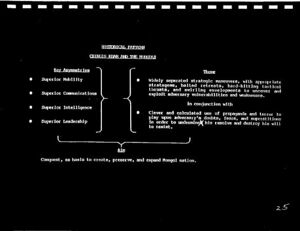Patterns of Conflict
| The works of |
| Works of John Boyd |
|---|
OODA WIKI Edition
Quantico Transcription
So moving forward, let’s go up to Chingis Khan and [unintelligible]. Incidentally, you might think I misspelled it, in the books it’s spelled differently and I don’t know who’s right. So I just spell it all different ways. So here it’s called Chingis Khan, in other words Chingis Khan with a “J,” and then you see Genghis Khan with a G, and I don’t know. So I didn’t misspell it, it’s just the way it is.
Okay. Key asymmetries: the idea that they had superior mobility over their adversaries, superior communication, superior intelligence. We’re not talking about intelligence here but intelligence service, and superior leadership. The kind we call more today by general intention, instead of having detailed orders, general intention of what’s to be done, and the local commanders on the spot decide how it’s going to be done. Okay, very modern in that sense.
So with these concepts, these themes, note all this kind of thing he’s doing, in other words literally trying to pull his adversary apart. You see that. In conjunction with propaganda and terror, used it very cleverly. In fact, one of the things they would do, if they had to take the city,
which they didn’t like to do, it would cost a lot of troops, and they’d slaughter all the people and let a few of the people go, so you tell the other cities what’s going to happen to them if they didn’t surrender. So you see they got a combination of propaganda and terror.
Another thing they would pull off if they wanted to take a city, they’d gather all the subjects out from the outlying areas and they’d march them in front of the Mongol troops, so if the city had to defend itself it had to clean out their own people first. These were nice guys.
And of course this is the basic idea. Okay? Now, let me give an example here in a sense of how they operated.
